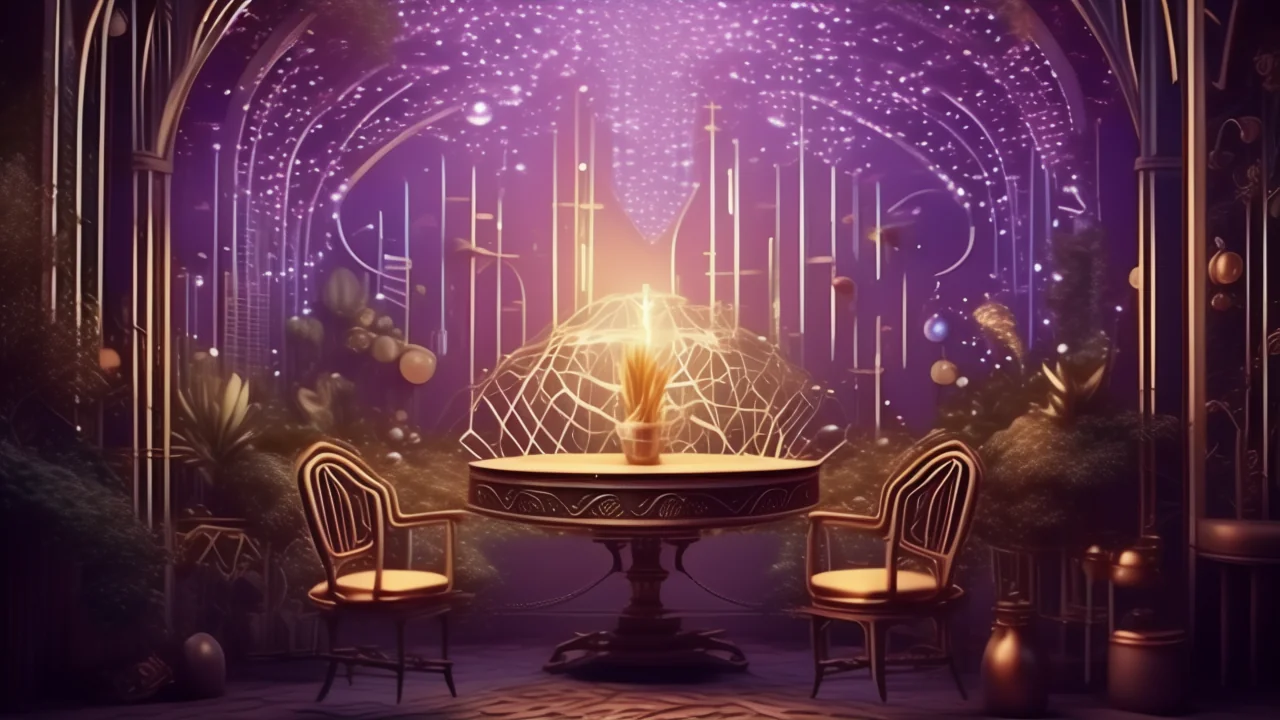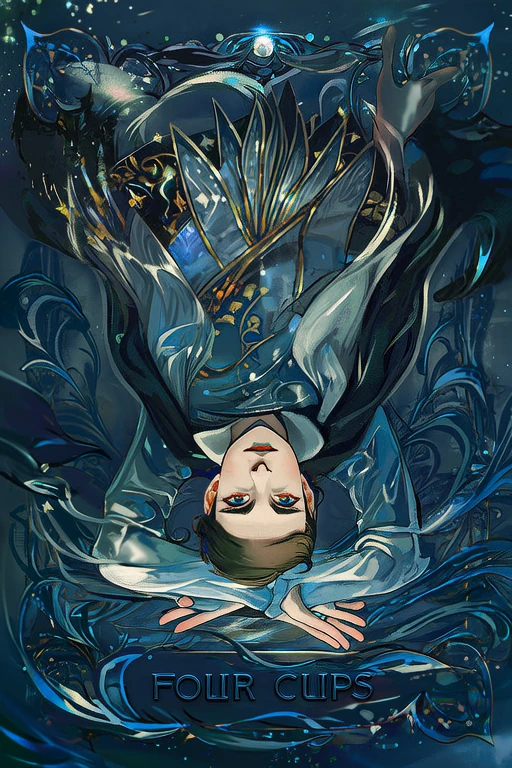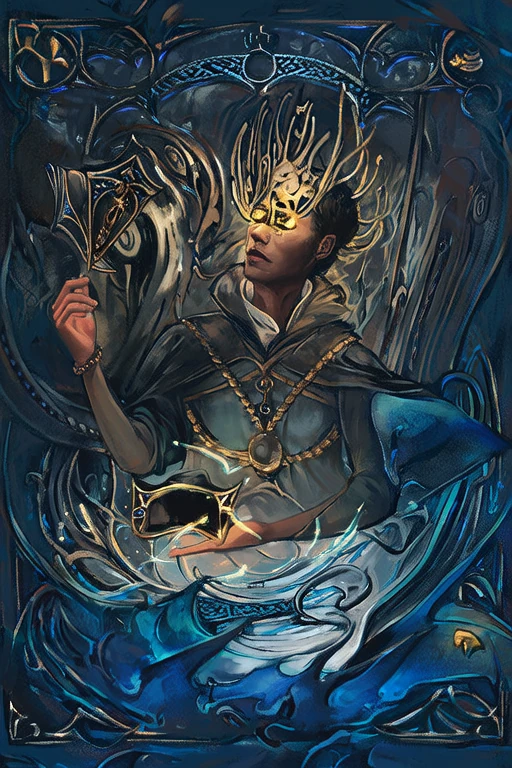
Four of Cups
Discover the deep meaning of Four of Cups with our free AI-powered tarot interpretation. Get instant, accurate readings based on advanced tarot knowledge.

Keywords
Upright Meaning
Contemplation, disconnectedness, boredom
Reversed Meaning
Re-evaluation, inner alchemy, pessimism
Full Interpretation
The Four of Cups represents contemplation, feeling disconnected, and seeking deeper meaning.
In-Depth Analysis
📜 Historical Background
The Four of Cups, known in Chinese as 圣杯四 (Shèngbēi Sì), is part of the Minor Arcana in the traditional tarot deck, specifically belonging to the suit of Cups, which corresponds to the element of Water and is associated with emotions, relationships, and intuition. Its origins trace back to early 15th-century Europe, particularly in Italy and France, where tarot cards were first used for card games before evolving into tools for divination and esoteric study.
In the earliest known tarot decks, such as the Visconti-Sforza and the Marseille Tarot, the Four of Cups was depicted with a more simplistic design—often showing four chalices arranged symmetrically on a table or in the hands of figures. These early representations emphasized stability, abundance, and emotional fulfillment, aligning with the number four's traditional symbolism of structure and foundation.
Over time, especially during the occult revival of the late 19th and early 20th centuries, the card’s imagery became more symbolic. The Rider-Waite-Smith deck (1909), illustrated by Pamela Colman Smith under the guidance of A.E. Waite, introduced a more narrative and psychologically rich depiction. In this version, a contemplative figure sits beneath a tree, seemingly indifferent to three cups placed before him, while a fourth cup is offered from above by a mysterious hand emerging from a cloud. This image introduced themes of introspection, apathy, and missed opportunities—marking a shift from purely material interpretations to more psychological and spiritual ones.
Different tarot traditions have interpreted the Four of Cups in various ways. In the Thoth Tarot, designed by Aleister Crowley and Lady Frieda Harris, the card is titled “Luxury” and is associated with Venus in the sign of Pisces, emphasizing emotional indulgence and spiritual richness. In contrast, some modern decks, especially those influenced by Eastern philosophies or Jungian psychology, may portray the card as a symbol of emotional stagnation or the need for inner renewal.
Culturally, the Four of Cups has been linked to myths involving emotional detachment and spiritual awakening. In some interpretations, it is associated with the myth of Narcissus, who becomes so enamored with his reflection that he neglects the world around him—a metaphor for being lost in one's emotions. In other traditions, it is seen as a call to mindfulness and the importance of recognizing blessings that may be overlooked.
Throughout history, the Four of Cups has evolved from a symbol of material stability to a nuanced representation of emotional introspection and spiritual awakening. Its journey through time reflects broader changes in how societies understand the inner emotional life and the pursuit of meaning beyond the material world.
Symbolism & Imagery
The Four of Cups is rich in symbolic meaning, with each visual element contributing to its layered interpretation. In the Rider-Waite-Smith version, the central figure sits in a contemplative pose beneath a tree, symbolizing a state of emotional stagnation or introspection. The three cups before him represent the emotional stability and opportunities already present in his life, while the fourth cup being offered from above signifies a new emotional opportunity or spiritual insight that he may be ignoring or failing to recognize.
The tree beneath which the figure sits is often interpreted as the Tree of Life, a symbol found in many mystical traditions, representing growth, connection between the earthly and divine realms, and the cyclical nature of life. The landscape behind the figure—typically a serene, rolling countryside—reflects emotional calmness or stagnation, depending on the reader’s interpretation. Some see it as a metaphor for emotional complacency, while others view it as a call to look inward and reassess one’s emotional landscape.
Colors also play a significant symbolic role. The green of the tree and landscape represents growth, harmony, and emotional healing. The red of the figure’s clothing suggests passion or vitality, yet it is tempered by the blue of his cloak, symbolizing introspection and emotional depth. The white of the mysterious hand offering the cup signifies purity and spiritual insight, suggesting that the new opportunity may come from a higher source or inner wisdom.
Numerologically, the number four is associated with stability, structure, and foundation. In the context of the Cups suit, this suggests a foundational emotional state that may be either secure or stagnant. The card’s placement as the fourth in the suit reflects a point of emotional consolidation—either a time to rest and reflect or a moment to re-evaluate whether one is truly fulfilled.
In different cultural contexts, the Four of Cups can take on varying meanings. In some Eastern interpretations, it may be seen as a call to mindfulness and the importance of recognizing blessings in the present moment. In Western psychological readings, it often represents emotional detachment or the need to break free from complacency.
When the card appears upright, it typically signifies emotional apathy, missed opportunities, or a need for introspection. It may indicate that the querent is too absorbed in their current emotional state to notice new opportunities around them. Reversed, the Four of Cups often signals a reawakening of emotional awareness, a realization that new possibilities are emerging, or a decision to step out of emotional stagnation.
This card also has connections to other cards in the deck. It shares thematic similarities with the Nine of Cups, which represents emotional fulfillment, and contrasts with the Three of Cups, which celebrates emotional connection and community. It also resonates with the Hermit, suggesting a need for solitude and reflection, and can be seen as a precursor to the Five of Cups, which deals with emotional loss and regret.
Ultimately, the Four of Cups invites the querent to pause, reflect, and consider whether they are truly satisfied with their current emotional state or if they are missing opportunities for deeper fulfillment.
Psychological Insights
From a psychological perspective, the Four of Cups resonates deeply with Carl Jung’s concept of the shadow self and the process of individuation. The card often represents a moment of emotional stagnation or inner conflict, where the querent may be unconsciously avoiding growth or new emotional experiences. This aligns with Jungian archetypes such as the Hermit, who symbolizes introspection and the search for inner truth, and the Persona, which reflects how we present ourselves to the world while potentially ignoring our deeper emotional needs.
In modern life, the Four of Cups serves as a powerful reminder to examine one’s emotional landscape and assess whether complacency or dissatisfaction is preventing personal growth. It may appear during times of emotional inertia—when someone is stuck in a routine, relationship, or mindset that no longer serves them but feels familiar and safe. Psychologically, this card encourages self-awareness and the courage to recognize when change is necessary, even if it feels uncomfortable.
For decision-making, the Four of Cups advises a pause and reflection. It suggests that the querent may be overlooking valuable opportunities due to emotional fatigue or preoccupation with past experiences. In career or relationship readings, it may indicate that the person is emotionally detached from their current situation and needs to reconnect with their true desires before making a decision.
Therapeutically, the Four of Cups can be a valuable tool in counseling and self-reflection. It invites individuals to explore their emotional patterns, particularly tendencies toward withdrawal, apathy, or resistance to change. Counselors and life coaches may use this card to help clients identify emotional blocks, examine unfulfilled needs, and encourage a shift toward more conscious emotional engagement with life.
In the realm of modern spirituality, the Four of Cups supports practices such as meditation, journaling, and shadow work. It encourages a deeper exploration of one’s inner world, helping individuals recognize when they are spiritually or emotionally numb. Many practitioners use this card as a prompt to reconnect with gratitude, mindfulness, and the present moment, reminding them that sometimes the greatest opportunities come not from external circumstances but from a shift in internal perspective.
Ultimately, the Four of Cups serves as a mirror to the soul, urging individuals to look inward and ask whether they are truly content or simply avoiding the discomfort of change. It challenges the querent to awaken to new emotional possibilities and embrace the growth that comes from self-awareness and intentional living.
Correspondences
The Four of Cups is deeply connected to the element of Water, symbolizing emotions, intuition, and the subconscious mind. In astrology, it is associated with the planet Venus in the sign of Pisces, blending the energies of love, beauty, and harmony (Venus) with the dreamy, spiritual nature of Pisces. This planetary and zodiacal influence enhances the card’s themes of emotional depth, sensitivity, and the need for spiritual fulfillment.
Gemstones and crystals linked to the Four of Cups include aquamarine, rose quartz, and amethyst. Aquamarine promotes emotional clarity and helps dissolve emotional blockages. Rose quartz nurtures self-love and compassion, encouraging the querent to open their heart to new emotional experiences. Amethyst aids in spiritual awareness and emotional healing, making it a powerful ally for those seeking to move beyond emotional stagnation.
Herbs and essential oils that resonate with this card include lavender, chamomile, and sandalwood. Lavender soothes emotional tension and promotes inner peace. Chamomile supports emotional balance and gentle introspection. Sandalwood deepens spiritual connection and enhances meditation, aligning with the card’s call for inner reflection.
Seasonally, the Four of Cups is most aligned with late winter to early spring, a time of transition and emotional renewal. It also corresponds to the late afternoon, when the sun begins to set and the mind turns inward, reflecting on the day’s experiences.
Energetically, this card is connected to the Heart Chakra (Anahata), which governs love, compassion, and emotional balance. When the Four of Cups appears, it may indicate a need to heal emotional wounds, open the heart to new possibilities, or release emotional stagnation that is blocking personal growth.
Numerologically, the number four represents stability, structure, and foundation. In the context of the Cups suit, it suggests that the emotional state represented by this card is well-established, but may require reassessment to ensure it is truly fulfilling. The Four of Cups invites the querent to build emotional foundations that are both secure and open to growth.
❓ Frequently Asked Questions
The Four of Cups often raises questions among both beginners and experienced readers due to its complex symbolism and emotional depth. One of the most common questions is: 'Does the Four of Cups mean I’m unhappy with my life?' The answer depends on the context of the reading. Upright, it may suggest emotional apathy or missed opportunities, indicating that the querent may be too focused on what they already have or what they lack to notice new possibilities. However, it doesn’t necessarily mean unhappiness—it’s more about emotional stagnation and the need for self-reflection.
Another frequently asked question is: 'Is the Four of Cups a negative card?' While it can highlight emotional complacency or missed chances, it is not inherently negative. Instead, it acts as a wake-up call, urging the querent to become more aware of their emotional state and consider whether they are truly fulfilled or simply stuck in a routine.
Beginners often misinterpret the Four of Cups as a card of rejection or denial, especially due to the figure’s apparent indifference to the fourth cup. Clarification is needed: the card does not suggest that opportunities are being taken away, but rather that the querent may be overlooking or resisting them due to emotional fatigue or internal conflict.
Professional tarot readers often use specific spreads to explore the Four of Cups in depth. The Three-Card Spread (Past, Present, Future) can help identify how emotional patterns have developed and where growth may occur. The Celtic Cross Spread is also effective, especially when the card appears in the 'Hopes and Fears' or 'Challenges' positions, revealing underlying emotional tensions.
How the Four of Cups interacts with other cards can significantly alter its meaning. When paired with the Two of Cups or the Lovers, it may indicate emotional reconciliation or a new romantic opportunity. With the Five of Cups, it warns against clinging to past disappointments. When combined with the Hermit, it reinforces the need for solitude and introspection. Conversely, when appearing with the Ace of Cups or the Star, it signals the arrival of new emotional or spiritual possibilities after a period of stagnation.
For practical interpretation, consider the querent’s current emotional state and life circumstances. In career readings, the Four of Cups may suggest a need to reevaluate job satisfaction or consider new opportunities. In relationships, it may point to emotional distance or the need for deeper connection. Spiritually, it encourages mindfulness and a return to inner balance. Ultimately, the Four of Cups invites the querent to pause, reflect, and ask whether they are truly open to the emotional gifts life has to offer.
Practical Readings
Love Reading – Free • Online • AI • Instant • Accurate
In love, Four of Cups upright: Contemplation, disconnectedness, boredom. Reversed: Re-evaluation, inner alchemy, pessimism.
Career Reading – Free • Online • AI • Instant • Accurate
For career, Four of Cups upright: Contemplation, disconnectedness, boredom. Reversed: Re-evaluation, inner alchemy, pessimism.
Yes‑No Reading – Free • Online • AI • Instant • Accurate
As a quick yes‑no: upright tends toward “yes”, reversed leans “no”—interpret within your question’s context.
FAQ
What does Four of Cups mean in tarot?
Four of Cups represents contemplation, disconnectedness, boredom. This card encourages The Four of Cups represents contemplation, feeling disconnected, and seeking deeper meaning.
What is Four of Cups reversed meaning?
When Four of Cups appears reversed, it signifies re-evaluation, inner alchemy, pessimism. Consider areas that may require adjustment or release.
Is Four of Cups a positive card?
Four of Cups is generally considered a neutral to positive card, representing contemplation, disconnectedness, boredom.
What should I do if I draw Four of Cups?
If you draw Four of Cups, focus on contemplation, disconnectedness, boredom. Align actions with the card’s upright energy.
How do I interpret Four of Cups in a love reading?
In love readings, Four of Cups suggests contemplation, disconnectedness, boredom in relationships. Consider how contemplation and disconnectedness apply to your situation.
What does Four of Cups mean in a love reading?
In love, Four of Cups points to contemplation, disconnectedness, boredom when upright and re-evaluation, inner alchemy, pessimism reversed. Reflect on relational balance & authenticity.
How is Four of Cups interpreted in career?
For career, Four of Cups upright highlights contemplation, disconnectedness, boredom while reversed warns of re-evaluation, inner alchemy, pessimism—adjust planning & execution.
What is the financial meaning of Four of Cups?
Financially, Four of Cups suggests contemplation, disconnectedness, boredom potential; reversed indicates re-evaluation, inner alchemy, pessimism—use prudent pacing.
Is Four of Cups a yes or no card?
Four of Cups is generally a context-dependent when upright; reversed leans toward hesitation or NO—apply to the nuance of your question.
References
References
- Encyclopaedia Britannica – Tarot
Historical overview and cultural context of tarot cards.
- Wikipedia – Tarot
General reference on tarot history, structure, and usage.
- Biddy Tarot – Tarot Card Meanings
Widely cited interpretations and learning resources.
- Labyrinthos – Tarot Card Meanings
Educational articles on major and minor arcana.



